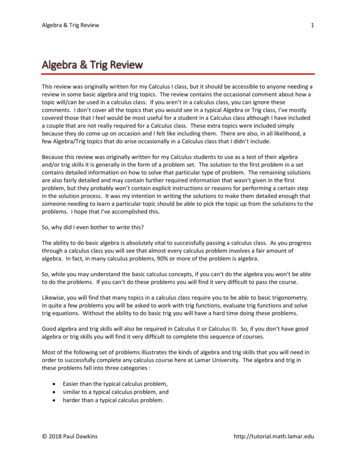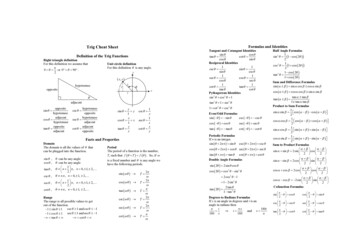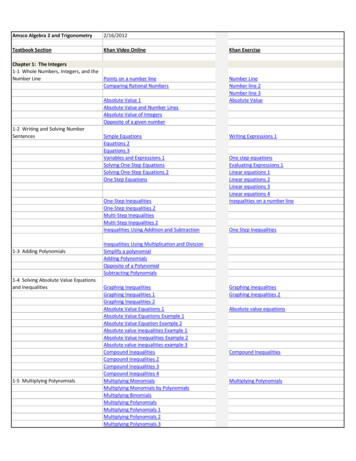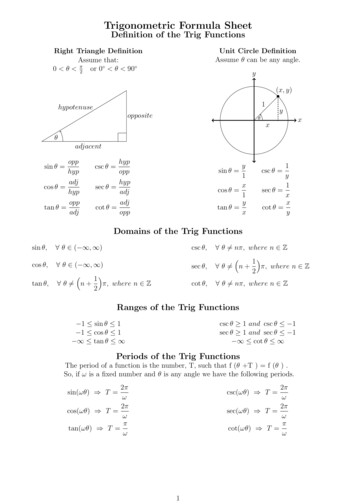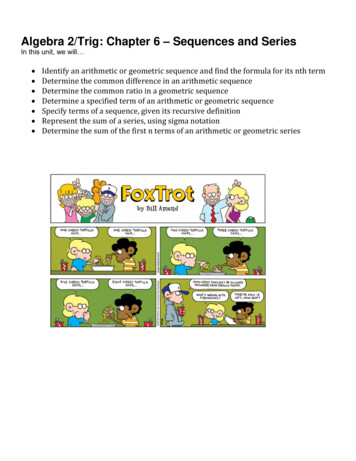
Transcription
Algebra 2/Trig: Chapter 6 – Sequences and SeriesIn this unit, we will Identify an arithmetic or geometric sequence and find the formula for its nth termDetermine the common difference in an arithmetic sequenceDetermine the common ratio in a geometric sequenceDetermine a specified term of an arithmetic or geometric sequenceSpecify terms of a sequence, given its recursive definitionRepresent the sum of a series, using sigma notationDetermine the sum of the first n terms of an arithmetic or geometric series
Table of ContentsDay 1: Arithmetic and Geometric SequencesSWBAT: Identify an arithmetic or geometric sequence and find the formula for its nth term Determine the common difference in an arithmetic sequence Determine the common ratio in a geometric sequence Determine a specified term of an arithmetic or geometric sequence Specify terms of a sequence, given its recursive definitionPgs. 1 – 6 in PacketHW: Pgs. 7 – 9 in PacketDay 2: More with Arithmetic & Geometric SequencesSWBAT: Identify an arithmetic or geometric sequence and find the formula for its nth term Determine the common difference in an arithmetic sequence Determine the common ratio in a geometric sequence Determine a specified term of an arithmetic or geometric sequence Specify terms of a sequence, given its recursive definitionPgs. 10 – 14 in PacketHW: Pgs. 15– 17 in PacketQUIZ on Day 3 7 minDay 3: SeriesSWBAT: Represent the sum of a series, using sigma notation Determine the sum of the first n terms of an arithmetic or geometric seriesPgs. 18 – 22 in PacketHW:Pgs. 23 – 27 in PacketDay 4: Sequences and Series Mixed PracticeSWBAT: Review problems involving Sequences and SeriesPgs. 28 – 32 in PacketQUIZ on Day 4 15 minDay 5: Practice TestDay 6: Test(Not in Packet)
Lesson #1: Arithmetic and Geometric SequencesDefinition of a sequence:Example 1:Example 2:Concept 1: Ways to define a sequenceThere are two ways to define a sequence: or .An explicitly defined sequence is like a formula. Plugging into the formula givesthe terms of the sequence. Subscripts name terms. They are not values in the problem.Example 3: Considersequence. 3n 2. Find the first 3 terms () of thisA recursively defined sequence has two parts;(1) It gives the first term and(2)all of the other terms are found using operations on the previous term(s)Key Points for Recursive Formulas Subscripts name terms. They are not values in the problem. If the next term isFor example, ifan the term before it will be an 1 because n-1an is a3 , an 1 is a2 . If the next term isFor example, ifan 1 the term before it will be an because nan 1 is a3 , an is a2 .Bottom Line: Build off the last term!is one smaller than n.is one smaller than n 1.1
For each problem, find the next four terms.Example 4:Example 5:a1 4an 1 an 102a1 5an an 1 nLabel the following as either an Explicit Formula or a Recursive Formula.2
Arithmetic SequencesIf a sequence of values follows a pattern of adding a fixed amount from one term to the next,it is referred to as an arithmetic sequence. The number added to each term is constant(always the same). The fixed amount is called the common difference, d.a) The following is an example of an arithmetic sequence: 3,8,13,18,23 . . .What is the common difference, d?71b) What is the common difference of the following arithmetic sequence?: 5, , 2, , . . .22Geometric SequencesIf a sequence of values follows a pattern of multiplying a fixed amount (not zero) times eachterm to arrive at the following term, it is referred to as a geometric sequence. The numbermultiplied each time is constant (always the same). The fixed amount is called the commonratio, r.a) The following is an example of a geometric sequence: 8,56,392, 2744 . . .What is the common ratio, r?b) What is the common ratio of the following geometric sequence?: 27, 9, 3, 1,,.Concept 2: Generating a SequenceA sequence can be defined by a formula (or generator) which generates eachterm. (Note: the variable “n” appears in most generator. It is used to indicate the position of a term in asequence.) The formula to generate any arithmetic sequence can be written inthe form: The formula to generate any geometric sequence can be written inthe form:3
Example 6: Find a formula to generate the arithmetic sequence 3, 5, 7, and use it togenerate the 50th term.Step 1:Step 2:Example 7: Find a formula to generate the geometric sequence 4, 12, 36, and use it todetermine the 19th term.Step 1:Step 2:4
You Try it!Determine if the sequence is arithmetic. If it is, find the common difference, the termnamed in the problem, and the explicit formula.Determine if the sequence is geometric. If it is, find the common ratio, the term named inthe problem, and the explicit formula.5
SUMMARYExit Ticket1.2.6
7
8
9
Lesson #2: More with Arithmetic & Geometric SequencesWARM-UP!Writing Sequences using equations practice1)an 3n 2What type of sequence is this?Write the first 5 terms of the sequence:2) 1 an 162 3 n 1What type of sequence is this?Write the first 4 terms of the sequence:3)an 3( 2)nWhat type of sequence is this?Write the first 5 terms of the sequence:4)1an 6 ( n 1)2What type of sequence is this?Write the first 5 terms of the sequence:5)a1 1 and the common difference of this arithmetic sequence is -3.Write the first 4 terms of the sequence:Write the explicit equation of this sequence:6)a1 2 and the common ratio of this geometric sequence is 10.Write the first 4 terms of the sequence:Write the explicit equation of this sequence:10
7) Write an explicit equation for the sequence:94 4, 3, 2, , , .23 98) Write an explicit equation for the sequence: -7.8, -5.6, -3.4, -1.2, . . .11
Concept 1: Arithmetic MeanArithmetic mean- the mean average between any two numbers of a sequence-a missing term can be found by finding the arithmetic mean of two terms.Ex: Given the arithmetic sequence 84, , 110 , find the missing term.Arithmetic mean 97Ex: Find the missing term of each arithmetic sequence.1) 16, , 362) 23, , , 173) 12, , , , 04) If 80 and 32 in a arithmetic sequence, find the 24th term.12
Concept 2: Geometric MeanGeometric mean- the positive square root of the product of two numbers of a sequence-A missing term can be found by finding the geometric mean of two termsEx: Given: 20, , 80Step 1:Step 2:Step 3:Find the missing term of each geometric sequence.1) 3, , 18.752) 28, , , 96043) 19,683, , , , 2434) If -6 and -1296 in a geometric sequence, find the 14th term.13
SUMMARYExit Ticket1)2)14
HW – Day 2Two important types of sequences are arithmetic sequences andgeometric sequences. Try to figure out which is which, and fill in themissing number in each sequence.arithmetic or geometric1) 4, 7, 10, , 16, . . . 2) 2, 4, 8, 16, , . . .3) 1, , 9, 27, 81, . . .4) 3.5, 6, 8.5, 11, , . . .5) 8, 12, 18, , 40.5, . . .6) , -5.5, -9.5, -13.5, . . .7) 256, 64, 16, 4, , . . .8) -4, 8, -16, 32, -64, , . . .15
16
Day 2 - Answers17
Day 3 – SeriesReview of Summation NotationLast value for the index variable5Symbol that tells us to addIndex variable (the one weplug the values into) Find each sum.41. a2Plug the values into thisexpression and add up each term kk 2First value for the index variable 2aa 12.A series is the sum of the terms in a sequence. On the first page of this lesson, you reviewedthe different ways we have used summation notation so far this year.1.Which of the following represents the sum 8 12 16 20 24?4(1) 8 aa 04(2)5(3) 8 4aa 0 8 4(a 1)a 14(4) 8 4aa 0Solution:18
You try it!2.Which of the following represents the sum 3 8 15 24 . . . 80?9(1) 3 5(n 1)n 19(3) n2 1n 19 n(2)2 1n 280 n(4)n 33.Imagine having to find the sum of the arithmetic series 3 6 9 . . . 129 132 by hand.25Imagine having to find the sum of the geometric series 4(3)k 1k 1by hand.Luckily there are formulas to find the sum of the first n terms of any arithmetic or geometricseries. Even more luckily, you do not have to memorize them because they are given to you onthe A2&T reference sheet.The rest of this lesson will deal with some problems you might encounter where you need to usethese formulas. You will also need to use the other formulas from the previous lessons to findthe numbers to plug into the formulas.Finding the nth term in an arithmetic sequence:19
Finding the nth term in a geometric sequence:1.Find the sum of the first 28 terms of the series 3 6 9 12 .(Hint: You need to find a28 first).2.Find the sum of the first 12 terms of the series, -3 6 - 12 24 - 48 .(Since this one is geometric, we do not needa12 )3.Evaluate this series using the series formula:4.Evaluate using the series formula:20
5.6.7.8.Find the sum of the first 20 terms of the sequence 4, 6, 8, 10, .21
9.Find the sum of the sequence -8, -5, -2, ., 710.Find the sum of the first 8 terms of the sequence -5, 15, -45, 135, .SUMMARYExit Ticket22
Day 3 – Series HWSum of Arithmetic SeriesNameSum of a Finite Arithmetic Series:Sn n(a1 an )21) Evaluate each arithmetic series.a) a1 4,an 22, n 10b) a1 2,100c) (2n 1)n 1e) 20, 23, 26, 29, . . . n 25an 156, n 1050d) (3n 2)n 1f) 20, 30, 40, 50, . . .n 3023
2) Determine the number of terms n in the following arithmetic series.a) a1 19,an 96, Sn 690b) a1 15,an 79, Sn 4233) Determine the sum of the all of the even integers from 2 to 2000.4) A company offers Sue a starting salary of 50,000 plus a guaranteed pay increase of5,000 each year. What is the total amount of money Sue will have earned after workingfor 25 years?24
Sum of Geometric SeriesNameSum of a Finite Geometric Series:a1 (1 r n )Sn 1 r1) Evaluate each geometric series.7a) (4k 112b))k 1n 1n 1c) 1, -4, 16, -64, . . .e) a1 4, 4 3n 9an 8748, r 3d) 1, 2, 4, 8, . . . n 30f) a1 4,an 1024, r 225
2) Determine the number of terms n in the following geometric series.a) a1 2,r 5, Sn 62b) a1 3,r 3, Sn 603) A company offers Jim a starting salary of 50,000 plus a guaranteed pay increase of5% each year. What is the total amount of money Jim will have earned after workingfor 25 years?26
Answers to Arithmetic SeriesAnswers to Geometric Series27
Day 4 - Sequences and Series Mixed Practice 20141. What is the difference between an arithmetic and a geometric sequence?2. Find the next three terms of each sequencea. 9, 16, 23, , ,b. 100, -200, 400, , ,c. -8, -5, -2,, ,3. Find the first three terms of each sequence where d is the common difference, and r is the common ratio12a. a1 576 , r , ,b. a1 2, d 13, ,53,d 88, ,c. a1 4. Find a 8 if an 4 3n . 1 5. Find a 7 if an 12 2 n 1.6. Find a12 for -17, -13, -9, 7. Find a 8 for 4, -12, 36, 28
8. Find a14 if a1 3 and the common difference is9. Find a 8 if the common ratior 3 and a1 d 71310. Write the equation for the nth term for each sequencea. 7, 16, 25, 34, b. 36, 12, 4, 11. Find the 10th term of the arithmetic sequence given the following information:a3 55, a7 11512. Find the 7th term of the geometric sequence given the following information: a1 9, a5 144Write the first 5 terms of each sequence described below with recursive equations:13.14.a1 3an 1 3an 10a1 5an an 1 4a1 215. a 2 1a n 2 a n 1 4a n29
Series QuestionsFind the value of each series below.316. ( 2 j 6)j 1317. 2( 4)18.6 j jkk 04j 1619. Find 2 x k if x3 2 , x4 4 , x5 8 and x6 10k 320. Write this series using sigma notation:21. Write this series using sigma notation:2 9 163 12 48 192 76830
Evaluate each arithmetic series.22. a1 2, a8 33 , S8 ?5023. (7n 1)n 1Evaluate each geometric series.1124. 5 3n 1n 125.1, 2, 4, 8, . . .n 2526. Determine the number of terms n in the following geometric series.a1 2, r 5, Sn 6231
27) Expand the following binomials. (Remember to fully simplify each term.)a)( x 3)5b)(a 2)6c)(3x 2 y)3d) Find the 3rd term of(2a2 3 y)7 .32
Algebra 2/Trig: Chapter 6 – . 2) Determine the number of terms n in the following arithmetic series. a) a 1 19, a n 96, S n 690 b) a 1 15, a n 79, S n 423 3) Determine the sum of the all of the even intege rs from 2 to 200 0. 4) A company offers Sue a sta
